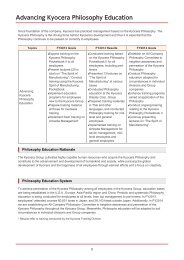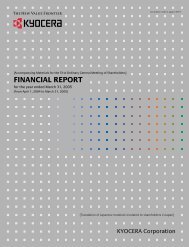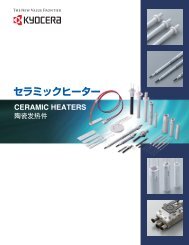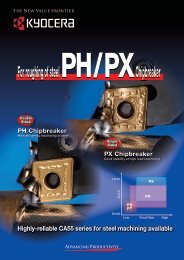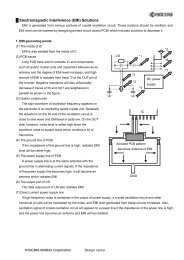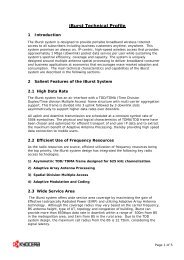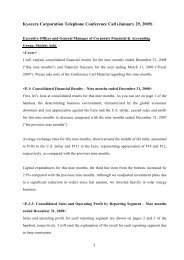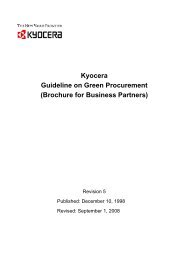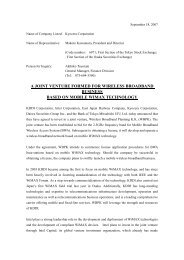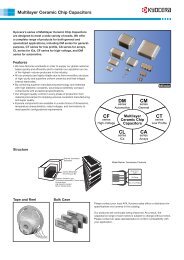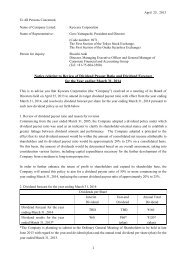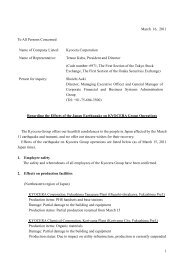Brochure for Business Partners - Kyocera
Brochure for Business Partners - Kyocera
Brochure for Business Partners - Kyocera
You also want an ePaper? Increase the reach of your titles
YUMPU automatically turns print PDFs into web optimized ePapers that Google loves.
Note 1: The present guidelines include the latest in<strong>for</strong>mation of European RoHS directives as of September<br />
2008.<br />
Note 2: The present guidelines apply to packing materials used <strong>for</strong> products released to our customers but do not<br />
apply to packaging and packing material used <strong>for</strong> products delivered to our company (see page 3 of the<br />
guideline <strong>for</strong> packaging and packing material of delivered products.)<br />
Note 3: This does not apply to non-radioactive reagents <strong>for</strong> measurement, analysis or research.<br />
Note 4: This does not apply to substances enclosed hermetically in a piece of equipment, a device or a fixture at<br />
any stage during purchase, use and disposal.<br />
Note 5: Typical materials that belong to each material classification are listed on attached table 5 in this table.<br />
*1: This is a number assigned to each substance group by JGPSSI <strong>for</strong> classification of the substance.<br />
*2: Intentional use of prohibited materials (rank B) is not acceptable.<br />
However, lead intentionally used <strong>for</strong> electroless plating is acceptable if it is controlled to the threshold<br />
value of 1000 ppm.<br />
Impurities more than the threshold value is prohibited per each part of components.<br />
(Please refer the chart on page 5.)<br />
*3: For packaging and packing material subject to Note 2, the total content of four heavy metals (cadmium,<br />
lead, mercury, and hexavalent chromium compounds) shall not exceed 100 ppm.<br />
*4: Nickel compounds except <strong>for</strong> metal alloys (<strong>for</strong> example: stainless steel).<br />
*5: Prohibition applies to short chain chlorinated paraffins with carbon numbers from 10 to 13.<br />
*6: Brominated flame retardant except <strong>for</strong> PBBs and PBDEs. Indicate with ISO code 1043-4 or CAS No.<br />
*7: Specific amines are listed in Table 3.<br />
*8: Prohibition applies only to the following five chemical substances <strong>for</strong> which EU risk assessment has been<br />
conducted:<br />
Dibutyl phthalate, di (2-ethylhexyl) phthalate, diisononyl phthalate, diisodecyl phthalate, butyl benzyl<br />
phthalate<br />
*9: “Toxic substances, production of which is prohibited “under Article 16 of the Industrial Safety and Health<br />
Law.<br />
*10: “Class I specified chemical substance” prescribed in Article 1, En<strong>for</strong>cement Ordinance of Law<br />
Concerning Examination and Regulation of Manufacture and Handling of Chemical Substances<br />
*11: Council Directive of 27 July 1976 on the approximation of the laws, regulations and administrative<br />
provisions of the Member States relating to restrictions on the marketing and use of certain dangerous<br />
substances and preparations (76/769/EEC) and amended directives thereof<br />
- 19 -



